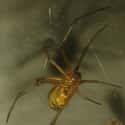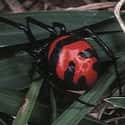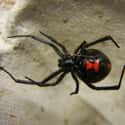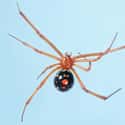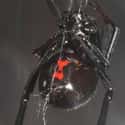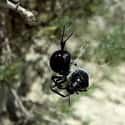-
(#3) Brown Widow
Species: Latrodectus geometricus
Size: 6 - 8mm in length.
Location: Though believed to originate in South Africa, the spider has been introduced in South America, Australia, Europe, North America, the Middle East, and many other places.
Distinguishing Features: Brown Widow spiders aren't black like their cousins, and instead have a mottling of brown and tan coloring on their bodies. The dorsal area has a longitudinal abdominal stripe, and three diagonal stripes on each flank. They do possess an hourglass marking, but it's orange in color, not red like others in the genus.
Why You Should Be Scared: The bites from a Brown Widow spider are often less toxic than those of the darker variety. This isn't due to the venom's toxicity, which is almost identical and is primarily due to the amount of venom injected in a bite. Their bites aren't as serious as other species, and will often result in a painful swollen red mark at the bite location. There have been reports of hospitalizations, but these are rarer than bites from other Widow spiders.
-
(#8) Latrodectus Elegans
Species: Latrodectus elegans
Size: Up to 9.53mm in length.
Location: L. elegans can be found in India, Myanmar, China, and Japan. It was first identified in the late-19th century, when it was collected in the Carin Cheba mountains in Myanmar, Thailand.
Distinguishing Features: L. elegans is predominantly black in color, though it features a unique marking on the back of its abdomen, which appears as three stripes with two of the rear, red stripes connected by a perpendicular stripe. They have a red marking on their underside, which somewhat resembles an hourglass, but looks more like a large "U" with a dot at the base.
Why You Should Be Scared: They possess venom in the same level of toxicity as other members of the genus, and cause significant pain at the bite location.
-
(#5) Southern Black Widow
Species: Latrodectus mactans
Size: 4 - 13mm in length.
Location: The Southern Black Widow is found predominantly in the southeastern United States, and can spread as far west as Texas and as far north as Ohio. It occasionally overlaps with L. variolus, and due to their similar appearance, they are often confused with one another.
Distinguishing Features: Unlike the L. variolus, the L. mactans' hourglass connects in much the same way as other species in the genus. They are consistently black with a bright red hourglass, and while they may have other markings on their backs.
Why You Should Be Scared: The males of the species are tiny and harmless when compared to the females, which is common for all species within the genus and family. Bites from the females can be fatal, but only in the rarest of circumstances. Typically, a bite will cause significant pain via latrodectism, which results in severe pain and redness at the bite site. Passings have been recorded, but they do not occur in otherwise healthy adults.
-
(#11) Red Widow
Species: Latrodectus bishopi
Size: Up to 12.7mm in length.
Location: The Red Widow spiders are found only in Florida, where they typically live in and around the sand dunes dominated by sand pines. These are found int he central and southern areas of the Sunshine State. Interestingly, its range is limited by its favored prey, which is any of five species of scarab beetles endemic to Florida scrub habitats.
Distinguishing Features: The abdomen of the Red Widow spider is black with red spots, but the rest of the body, head, and legs are vermillion red in color.
Why You Should Be Scared: Red Widow spiders are nocturnal and don't typically bite humans unless disturbed. They possess the same venom as other species in the genus, and pose a similar threat, though they aren't known for causing any fatalities in humans.
-
(#4) Western Black Widow
Species: Latrodectus herperus
Size: 12.5 - 35mm in length.
Location: The Western Brown Widow prefers to live in warmer regions and can be found in all four deserts of the American southwest. Typically, they make their homes under ledges or rocks, in plants, and in various types of debris that helps shield it from the sun.
Distinguishing Features: The Western Black Widow spider looks much like other species in that it is black with a red hourglass on its underside. Their silk is particularly strong and registers at 100 MPa, which is significant, as steel measures at 800 MPa.
Why You Should Be Scared: Like other Widow species, the males are quite small and aren't harmful to humans, but the female — that's another story. Bites from females can require medical treatment, and occasionally, hospitalization in serious cases. Historical literature about the species places its lethality at 0.5% to as high as 12%, but this doesn't appear to be accurate, nor has it been confirmed.
-
(#9) Latrodectus Lilianae
Species: Latrodectus lilianae
Size: 12 - 16mm in length.
Location: These spiders are found primarily in the steppes of the Iberian Peninsula, and don't often live near human activity.
Distinguishing Features: L. lilianae is black in color and features a small, white, and orange markings on its abdomen.
Why You Should Be Scared: They carry venom like other members of the genus, but due to their preference to be located in places where humans don't typically go, the full effects of its venom are not currently known, though they possess enough venom to potentially be lethal in rare cases.
New Random Displays Display All By Ranking
About This Tool
Spiders are a kind of animal that is not to be underestimated. These small reptiles with a length of up to 30 centimeters can be found in every corner of the earth, guarding their territory fearlessly. With eight long legs and excellent eyesight, spiders are excellent predators, and they can always eat fresh prey. Widow spiders are poisonous and become one of the deadly spiders known in the world.
In recent years, with the expansion of the scope of human life, reports of humans and animals being bitten and killed by widow spiders are frequent all over the world. The random tool will help to know 12 fascinating facts about the most terrifying spiders.
Our data comes from Ranker, If you want to participate in the ranking of items displayed on this page, please click here.











